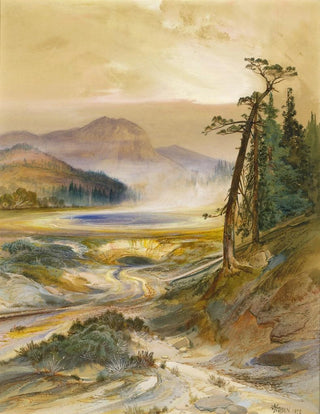Art print | Geyser Excelsior Yellowstone Park - Thomas Moran Source: Reproduction | Geyser Excelsior Parc de Yellowstone - Thomas Moran


View from behind

Frame (optional)
The art print "Geyser Excelsior Yellowstone Park" by Thomas Moran is much more than a simple depiction of a natural landscape; it is an open window into the majesty of American nature at the end of the 19th century. Through this canvas, Moran manages to capture the energy and beauty of the landscapes of Yellowstone National Park, a place that, at the time, was still largely unexplored. The artwork evokes an atmosphere of mystery and grandeur, inviting the viewer to immerse themselves in a world where earth, water, and sky meet in a breathtaking spectacle. The light, vibrant colors, and dynamic shapes intertwine to create a visual experience that transcends time and space, making this piece a true masterpiece of landscape art.
Style and uniqueness of the work
Thomas Moran's style is distinguished by his bold use of color and his ability to play with light. In "Geyser Excelsior Yellowstone Park," he deploys a palette of vivid hues that evoke the reflections of the sun on the tumultuous surfaces of water. Shades of blue, yellow, and white blend harmoniously, creating a striking contrast that immediately catches the eye. The geyser, depicted in a moment of power and movement, almost seems alive, as if about to erupt in a spray of water. The composition is carefully balanced, with each element precisely placed to guide the viewer's gaze through the scene. Moran thus succeeds in transforming a simple landscape into a narrative painting, where every detail tells a story of wild and untamed nature.
The artist and his influence
Thomas Moran, often regarded as one of the pioneers of American Impressionism, played a vital role in promoting American landscapes through his works. His trip to Yellowstone in 1871 was decisive, not only for his career but also for how the public perceived these natural landscapes. Moran was able to awaken awareness of the unmatched beauty of these lands, contributing to their preservation. His style, influenced by European masters while incorporating elements unique to America, paved the way

Matte finish

View from behind

Frame (optional)
The art print "Geyser Excelsior Yellowstone Park" by Thomas Moran is much more than a simple depiction of a natural landscape; it is an open window into the majesty of American nature at the end of the 19th century. Through this canvas, Moran manages to capture the energy and beauty of the landscapes of Yellowstone National Park, a place that, at the time, was still largely unexplored. The artwork evokes an atmosphere of mystery and grandeur, inviting the viewer to immerse themselves in a world where earth, water, and sky meet in a breathtaking spectacle. The light, vibrant colors, and dynamic shapes intertwine to create a visual experience that transcends time and space, making this piece a true masterpiece of landscape art.
Style and uniqueness of the work
Thomas Moran's style is distinguished by his bold use of color and his ability to play with light. In "Geyser Excelsior Yellowstone Park," he deploys a palette of vivid hues that evoke the reflections of the sun on the tumultuous surfaces of water. Shades of blue, yellow, and white blend harmoniously, creating a striking contrast that immediately catches the eye. The geyser, depicted in a moment of power and movement, almost seems alive, as if about to erupt in a spray of water. The composition is carefully balanced, with each element precisely placed to guide the viewer's gaze through the scene. Moran thus succeeds in transforming a simple landscape into a narrative painting, where every detail tells a story of wild and untamed nature.
The artist and his influence
Thomas Moran, often regarded as one of the pioneers of American Impressionism, played a vital role in promoting American landscapes through his works. His trip to Yellowstone in 1871 was decisive, not only for his career but also for how the public perceived these natural landscapes. Moran was able to awaken awareness of the unmatched beauty of these lands, contributing to their preservation. His style, influenced by European masters while incorporating elements unique to America, paved the way






